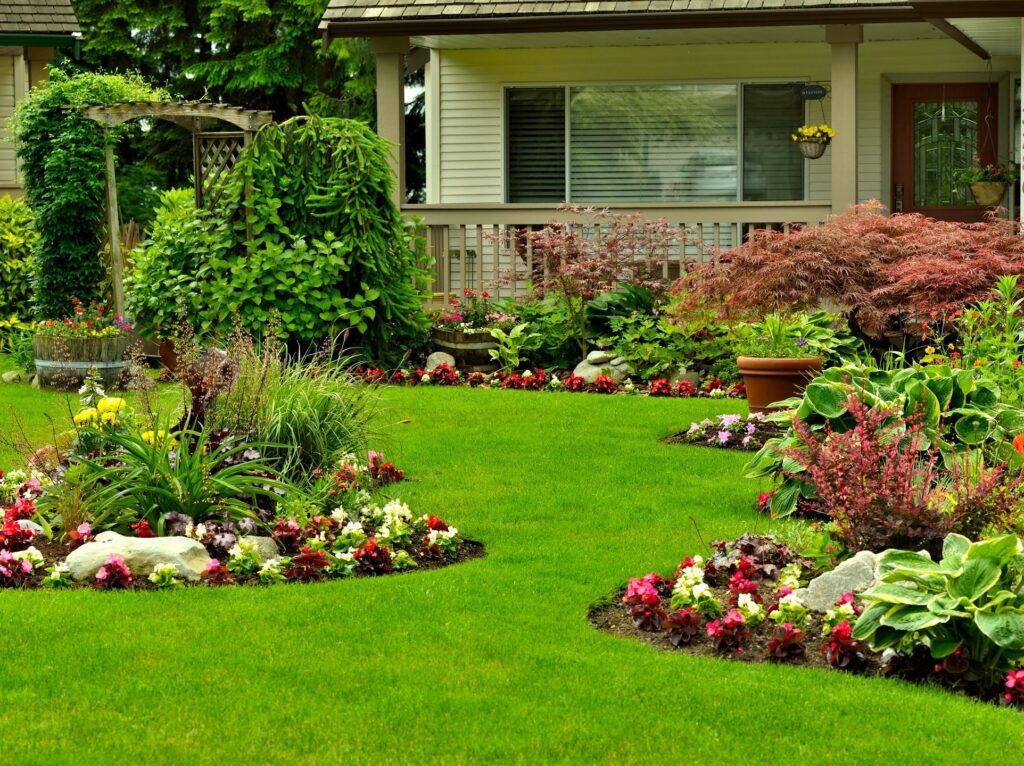Are you looking for tips on how to take care of your lawn this season? Whether you’re a beginner or a pro, you’ll find all the information you need in this guide. We’ll talk about everything from mowing and watering to fertilizing and weed control. By following these simple tips, you’ll be able to keep your lawn looking healthy all year long!
Whether spring, summer, fall, or winter, we have a lawn care guide to ensure your lawn is looking its best.

Basic Lawn Care Maintenance
#1: Mowing
Mowing is essential to keeping your lawn looking healthy and neat. Cutting your grass regularly helps reduce the risk of disease, pests, and weeds. Regular mowing also promotes thicker, healthier grass and improves the overall appearance of your lawn. When cutting your grass, be sure to use a sharp blade and mow at the correct height for the type of grass you have.
Spring:
For spring, mowing should begin when the grass is growing actively. You’ll want to keep your lawn short; aim for a height of two to three inches. Mow often, approximately once a week, and remove no more than one-third of the grass leaves at one time.
Summer:
You’ll want to continue mowing approximately once a week during the summer months. You may need to increase the height of your grass during this season slightly; aim for three to four inches. When cutting your grass, avoid scalping it by not removing more than one-third of the grass leaves at once.
Fall:
For fall, you’ll want to gradually lower the blade on your lawn mower as days get cooler and shorter. Aim for a lower height of two inches so that sunlight can reach the soil and help protect your lawn from diseases and pest infestations. Additionally, when mowing in fall, be sure to leave clippings on the lawn’s surface instead of raking them up.
Winter:
During winter, you won’t have to mow your lawn as often; however, a light trim may be necessary if the grass continues to grow. You’ll want to avoid cutting too low (no shorter than one inch), or you risk damaging the grass blade and inhibiting healthy growth in the spring.
#2: Watering
Watering is important to keep your lawn looking its best throughout the year. During dry periods, your lawn will need more water than usual – typically every three to seven days, depending on how hot it is outside. Be sure to water thoroughly so that water reaches down into the soil where the roots are growing.
In addition to regular watering, you may want to consider applying a layer of mulch around your plants. Mulch helps keep moisture in the soil and can reduce the amount of water you need to apply.
Spring:
For spring, your lawn should receive about one inch of water per week from natural rain or manual watering. If rainfall is low, be sure to supplement with manual watering using a sprinkler or garden hose.
Summer:
During summer months, your lawn will require more frequent and deeper watering sessions than in other seasons. Aim for one inch of water every three days during this season so that your grass stays healthy and lush throughout the hottest summer days.
Fall:
In fall, reduce the amount of water your lawn needs to about one inch per week. You can reduce the amount further if you notice fewer signs of wilt or if the soil is well-drained.
Winter:
Your lawn won’t need much watering this season, as turfgrass typically dorms during winter. However, if you receive less than one inch of rain in a given week, you should consider giving your grass a light sprinkle with a hose or sprinkler to keep it healthy and hydrated.
#3: Fertilizing
Fertilizing your lawn is essential to keeping it healthy and lush. Fertilizer helps strengthen the root system of your grass and promotes stronger, greener growth. It also helps protect against diseases, weeds, and pests.
Spring:
For spring, choose a fertilizer with a high nitrogen content to encourage new growth on your lawn. Apply when the first signs of green begin to emerge in late winter or early spring for best results.
Summer:
During the summer months, you’ll want to use a balanced fertilizer that has equal amounts of nitrogen and phosphorus – this will help your grass maintain its lush look during long periods without rain or irrigation. Aim for an application every four weeks during this season.
Fall:
When fall arrives, switch to a fertilizer with more phosphorus and potassium in it – these elements help build up the root system of your grass and are essential for winter survival. Spread this type of fertilizer over your lawn every four weeks or so throughout the fall season.
Winter:
During this season, you don’t have to fertilize as much; however, if temperatures remain mild for an extended period, a light application of nitrogen-rich fertilizer may be beneficial. This will help ensure that your grass is healthy come springtime.
#4: Weed Control
Weeds can be a nuisance to any lawn and often require consistent care in order to keep them at bay.
Spring:
Start the season off with an application of weed killer or pre-emergent herbicide to help control and prevent pesky weeds from taking over your lawn. This should be done when the first signs of green start emerging in late winter or early spring.
Summer:
In summer, apply a post-emergent herbicide twice a month, if needed, to help combat stubborn weeds that have already sprouted up on your lawn. Be sure to choose one that is safe for the type of grass you have planted in your yard.
Fall:
In fall, you may need to apply an additional layer of pre-emergent herbicide before the cold weather sets in, as this will help prevent weeds from emerging later on.
Winter:
During winter months, you won’t have to worry about weed control as much since most weeds become dormant during this season. However, if temperatures remain mild for an extended period of time, you may want to perform a light application just in case any stubborn weeds try to sprout up.
#5: Aeration
Aeration helps keep your lawn healthy and vibrant by allowing air, water, and nutrients to penetrate deep into the soil. This process should be done at least once a year, preferably in the fall or early spring.
Spring:
If you haven’t aerated your lawn in the fall, now is the ideal time to do so. This will ensure that air, water, and nutrients can reach all parts of your grassroots and help them grow strong for the upcoming summer months.
Summer:
You won’t have to worry about aerating during this season, as it’s best done when temperatures are cooler. However, if you notice signs of compaction (i.e., matted-down spots on your lawn), you may want to consider aerating sooner rather than later.
Fall:
This is the ideal time for aeration as conditions are usually cooler and more conducive to this type of activity. This should be done once a year at least, but if your lawn experiences heavy traffic during the summer months, you may want to consider doing it twice a year – once in fall and again in spring.
Winter:
Aerating your lawn in winter isn’t necessary unless temperatures remain mild for an extended period of time; however, if you see signs of compaction on your lawn even after aerating in fall or spring, then a light aeration session would be beneficial.
Lawn care is an important part of keeping a healthy, vibrant yard. By following this seasonal guide and tackling these tasks when they need to be done, you’ll be sure to have a beautiful lawn that will be the envy of your neighborhood.
Happy gardening!
If you want to avoid all the troubles but still keep your lawn in top-notch condition, Heroes Lawn Care is there to help. They offer all-season lawn care services, including mowing, weed control, aeration, and fertilizing, so you can sit back and relax while they take care of it all.



